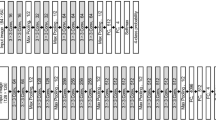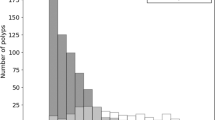Abstract
Purpose
Intraoperative ultrasonography (IOUS) of the liver is a crucial adjunct in every liver resection and may significantly impact intraoperative surgical decisions. However, IOUS is highly operator dependent and has a steep learning curve. We describe the design and assessment of an artificial intelligence (AI) system to identify focal liver lesions in IOUS.
Methods
IOUS images were collected during liver resections performed between November 2020 and November 2021. The images were labeled by radiologists and surgeons as normal liver tissue versus images that contain liver lesions. A convolutional neural network (CNN) was trained and tested to classify images based on the labeling. Algorithm performance was tested in terms of area under the curves (AUCs), accuracy, sensitivity, specificity, F1 score, positive predictive value, and negative predictive value.
Results
Overall, the dataset included 5043 IOUS images from 16 patients. Of these, 2576 were labeled as normal liver tissue and 2467 as containing focal liver lesions. Training and testing image sets were taken from different patients. Network performance area under the curve (AUC) was 80.2 ± 2.9%, and the overall classification accuracy was 74.6% ± 3.1%. For maximal sensitivity of 99%, the classification specificity is 36.4 ± 9.4%.
Conclusions
This study provides for the first time a proof of concept for the use of AI in IOUS and show that high accuracy can be achieved. Further studies using high volume data are warranted to increase accuracy and differentiate between lesion types.




Similar content being viewed by others
References
Lubner MG, Mankowski Gettle L, Kim DH, Ziemlewicz TJ, Dahiya N, Pickhardt P (2021) Diagnostic and procedural intraoperative ultrasound: technique, tips and tricks for optimizing results. Br J Radiol 94(1121):20201406. https://doi.org/10.1259/bjr.20201406
Kamiyama T, Kakisaka T, Orimo T (2021) Current role of intraoperative ultrasonography in hepatectomy. Surg Today 51(12):1887–1896. https://doi.org/10.1007/s00595-020-02219-9
Hagopian EJ (2020) Liver ultrasound: a key procedure in the surgeon’s toolbox. J Surg Oncol 122(1):61–69. https://doi.org/10.1002/jso.25908
Ellebaek SB, Fristrup CW, Mortensen MB (2017) Intraoperative ultrasound as a screening modality for the detection of liver metastases during resection of primary colorectal cancer -a systematic review. Ultrasound Int Open 3(2):E60–E68. https://doi.org/10.1055/s-0043-100503
Arita J, Ono Y, Takahashi M, Inoue Y, Takahashi Y, Matsueda K, Saiura A (2015) Routine preoperative liver-specific magnetic resonance imaging does not exclude the necessity of contrast-enhanced intraoperative ultrasound in hepatic resection for colorectal liver metastasis. Ann surg 262(6):1086–1091. https://doi.org/10.1097/SLA.0000000000001085
Scaife CL, Ng CS, Ellis LM, Vauthey JN, Charnsangavej C, Curley SA (2006) Accuracy of preoperative imaging of hepatic tumors with helical computed tomography. Ann Surg Oncol 13(4):542–546. https://doi.org/10.1245/ASO.2006.07.009
Solomon MJ, Stephen MS, Gallinger S, White GH (1994) Does intraoperative hepaticultrasonography change surgical decision making during liver resection? Am J Surg 168(4):307–310. https://doi.org/10.1016/s0002-9610(05)80154-0
Jrearz R, Hart R, Jayaraman S (2015) Intraoperative ultrasonography and surgical strategy in hepatic resection: what difference does it make? Can J Surg 58(5):318–322. https://doi.org/10.1503/cjs.016914
van Vledder MG, Pawlik TM, Munireddy S, Hamper U, de Jong MC, Choti MA (2010) Factors determining the sensitivity of intraoperative ultrasonography in detecting colorectal liver metastases in the modern era. Ann Surg Oncol 17(10):2756–2763. https://doi.org/10.1245/s10434-010-1108-y
Pazaiti A, Toutouzas KG, Papadimitriou DI, Papadopoulos BD, Papacostas LS, Strigaris KA, Papadimitriou JD (2009) Change in preoperative strategy based on intraoperative ultrasound findings. Int Surg 94(1):58–62
Sietses C, Meijerink MR, Meijer S, van den Tol MP (2010) The impact of intraoperative ultrasonography on the surgical treatment of patients with colorectal liver metastases. Surgicalendoscopy 24(8):1917–1922. https://doi.org/10.1007/s00464-009-0874-8
D’Hondt M, Vandenbroucke-Menu F, Preville-Ratelle S, Turcotte S, Chagnon M, Plasse M, Letourneau R, Dagenais M, Roy A, Lapointe R (2011) Is intra-operative ultrasound still useful for the detection of a hepatic tumour in the era of modern pre-operative imaging? HPB : Off J Int Hepato Pancreato Biliary Assoc 13(9):665–669. https://doi.org/10.1111/j.1477-2574.2011.00349.x
Zhou LQ, Wang JY, Yu SY, Wu GG, Wei Q, Deng YB, Wu XL, Cui XW, Dietrich CF (2019) Artificial intelligence in medical imaging of the liver. World J Gastroenterol 25(6):672–682. https://doi.org/10.3748/wjg.v25.i6.672
Yang Q, Wei J, Hao X, Kong D, Yu X, Jiang T, Xi J, Cai W, Luo Y, Jing X et al (2020) Improving B-mode ultrasound diagnostic performance for focal liver lesions using deep learning: a multicentre study. EBioMedicine 56:102777. https://doi.org/10.1016/j.ebiom.2020.102777
Zhou H, Jiang T, Li Q, Zhang C, Zhang C, Liu Y, Cao J, Sun Y, Jin P, Luo J et al (2021) US-based deep learning model for differentiating hepatocellular carcinoma (HCC) from other malignancy in cirrhotic patients. Front Oncol 11:672055. https://doi.org/10.3389/fonc.2021.672055
Tiyarattanachai T, Apiparakoon T, Marukatat S, Sukcharoen S, Geratikornsupuk N, Anukulkarnkusol N, Mekaroonkamol P, Tanpowpong N, Sarakul P, Rerknimitr R et al (2021) Development and validation of artificial intelligence to detect and diagnose liver lesions from ultrasound images. PLoS ONE 16(6):e0252882. https://doi.org/10.1371/journal.pone.0252882
Lupsor-Platon M, Serban T, Silion AI, Tirpe GR, Tirpe A, Florea M (2021): Performance of ultrasound techniques and the potential of artificial intelligence in the evaluation of hepatocellular carcinoma and non-alcoholic fatty liver disease. Cancers, 13(4). https://doi.org/10.3390/cancers13040790
Shuyang Sun JP, Jianping Shi, Shuai Yi, Wanli Ouyang (2018) FishNet: a versatile backbonefor image, region, and pixel level prediction. In: Computer Science, Environmental Science, NeurIPS. arXiv:1901.03495. https://doi.org/10.48550/arXiv.1901.03495
Tsung-Yi Lin MM, Serge Belongie, Lubomir Bourdev, Ross Girshick, James Hays, Pietro Perona, Deva Ramanan, C. Lawrence Zitnick, Piotr Dollár (2014) Microsoft COCO: common objects in context. arXiv:14050312. https://doi.org/10.48550/arXiv.1405.0312.
Bolei Zhou AK, Agata Lapedriza, Aude Oliva, Antonio Torralba (2016): Learning deep features for discriminative localization. arXiv:151204150v1.https://doi.org/10.48550/arXiv.1512.04150.
Ramprasaath R. Selvaraju MC, Abhishek Das, Ramakrishna Vedantam, Devi Parikh, Dhruv Batra (2019) Grad-CAM: visual explanations from deep networks via gradient-based localization. arXiv:161002391v4. https://doi.org/10.48550/arXiv.1610.02391
Machi J, Sigel B, Zaren HA, Kurohiji T, Yamashita Y (1993) Operative ultrasonography during hepatobiliary and pancreatic surgery. World J Surg 17(5):640–645. https://doi.org/10.1007/BF01659130 (discussion 645-646)
Schmauch B, Herent P, Jehanno P, Dehaene O, Saillard C, Aube C, Luciani A, Lassau N, Jegou S (2019) Diagnosis of focal liver lesions from ultrasound using deep learning. Diagn Interv imaging 100(4):227–233. https://doi.org/10.1016/j.diii.2019.02.009
Pezhman Pasyar TM, Kouzehkananc S-Z, Ahmadian A, Arabalibeik H, Soltanian N, Radmard AR (2021) Hybrid classification of diffuse liver diseases in ultrasound images using deep convolutional neural networks. Inform Med Unlocked 2021:22. https://doi.org/10.1016/j.imu.2020.100496
Chou TH, Yeh HJ, Chang CC, Tang JH, Kao WY, Su IC, Li CH, Chang WH, Huang CK, Sufriyana H et al (2021) Deep learning for abdominal ultrasound: a computer-aided diagnostic system for the severity of fatty liver. J Chin Med Assoc 84(9):842–850. https://doi.org/10.1097/JCMA.0000000000000585
Author information
Authors and Affiliations
Contributions
YB, study conception and design, acquisition of data, and drafting the manuscript. EK, analysis and interpretation of data and revising the draft critically for important intellectual content. AL, analysis and interpretation of data. EK, analysis and interpretation of data. NH, acquisition of data, analysis, and interpretation of data. RP, analysis and interpretation of data. NZ, acquisition of data. RE, acquisition of data. IN, acquisition of data and revising the draft critically for important intellectual content. NP, study conception and design, acquisition of data, and drafting the manuscript.
Corresponding author
Ethics declarations
Ethics approval
The study was performed in accordance with the ethical standards as laid down in the 1964 Declaration of Helsinki and its later amendments or comparable ethical standards and was approved by an institutional review board of the Sheba Medical Center, approval number — SMC-8729–21.
Consent to participate
Not required.
Conflict of interest
The authors declare no competing interests.
Additional information
Publisher's note
Springer Nature remains neutral with regard to jurisdictional claims in published maps and institutional affiliations.
Supplementary Information
Below is the link to the electronic supplementary material.
Rights and permissions
Springer Nature or its licensor holds exclusive rights to this article under a publishing agreement with the author(s) or other rightsholder(s); author self-archiving of the accepted manuscript version of this article is solely governed by the terms of such publishing agreement and applicable law.
About this article
Cite this article
Barash, Y., Klang, E., Lux, A. et al. Artificial intelligence for identification of focal lesions in intraoperative liver ultrasonography. Langenbecks Arch Surg 407, 3553–3560 (2022). https://doi.org/10.1007/s00423-022-02674-7
Received:
Accepted:
Published:
Issue Date:
DOI: https://doi.org/10.1007/s00423-022-02674-7




